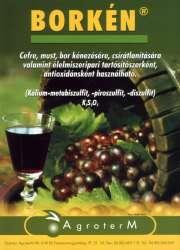Borkén 500g
Area of application and recommended dosage: when making mash: sprinkle over the ground mash or add to the wine as an ounce during the dorée and stir. In the juice, add the lees or use in the mash. 5-15 g/100 kg of mash per wine, depending on the state of the mash and the mash. Sulphurisation of must: add to must only if the mash has not been tre...
Long description
| HUF 1,582 * (nettó: HUF 1,246) | |
Shipping
face
Personal receipt of goods:
1-4 nap
info
A rendelés leadása és a termékek raktárunkba történő beérkezése után (1-4 nap) összekészítjük a csomagot, majd sms - ben vagy e - mailen értesítjük, hogy a termékek átvehetőek (Gazdabolt_2 üzletünkben, hétfőtől - péntekig 8:00 - 17:00 óra között).
By courier:
1-5 nap
info
A rendelés leadása után a futárszolgálat 1-7 munkanap alatt szállítja ki a csomagot, melyről e-mailben értesítjük.
Area of application and recommended dosage: when making mash: sprinkle over the ground mash or add to the wine as an ounce during the dorée and stir. In the juice, add the lees or use in the mash. 5-15 g/100 kg of mash per wine, depending on the state of the mash and the mash. Sulphurisation of must: add to must only if the mash has not been treated. The wine sulphur prevents the proliferation of wild yeasts and thus prevents the noble wine yeast strains from taking over, and also reduces the possibility of wine diseases. The addition to must is as follows: 10 g of boric acid per 1 hl of must for fresh, sweet must from a healthy harvest; 15 g of boric acid per 1 hl of must for slightly rotten musts and for microbiologically compromised musts; 20 g of boric acid per 1 hl of must for must made from rotten, mouldy grains; 30 g of boric acid per 1 hl of must for fresh must. Sulphurisation of wine, fruit wine: excellent for sulphurisation when decanting wine must. Light sulphurisation - 5-10 g of sulphur / 1 hl of wine - can be applied: first and second decanting for dry acid wines; second decanting for sweet or soft wines; for wines in the bottle; third decanting for healthy young white, siller, red and old wines. Medium sulphurisation - 20 g of wine per 1 hl of wine - can be used: at the first decanting for sweet wines, soft wines which are difficult to clarify; wines with a moderate or strong rotten egg smell; for crushed and crushed apple wines; in case of initial wine diseases. The free sulphuric acid content of each batch of wine should be measured and adjusted to between 30 and 50 mg/l, depending on the type of wine, ageing and storage method. The missing sulphuric acid content can be made up by adding 0,2 g of sulphur per hl of wine per mg/l. It is advisable to dissolve the required amount of wine in a small quantity of must or wine, mix well beforehand and add it to the larger batch! For pickling: for cabbage salad, mixed pickles (bait pickles), peppers, add 2.5 g of wine per 5 litre bottle. The pickles will not brown and the flesh will remain firm and crispy! Do not put the wine in boiling water! The quality complies with the standard MSZ 09-570004/84, the requirements of the European Community (EEC Food Grade E224) and the Food Chemical Codex. Moderately irritant, aqueous solution with slightly acidic chemistry. Occupational health and first aid precautions: Protective gloves are recommended for use on sensitive skin. The preparation releases sulphur dioxide when heated or exposed to acids. Overdosage of the preparation is unnecessary and may be dangerous! In the event of contact with eyes or skin, rinse with plenty of water.
| Weight: | 0.5 kg |
|---|---|
| Width: | 120 mm |
| Height: | 220 mm |
| Length: | 40 mm |
| Aviability: | 1-4 nap |
| Basic sales unit: | db |
| Culture: | Szőlő |
| Növényvédőszer forgalmazási kategória: | III. szabadforgalmú |
Login
Login or registration with a social account
Login
Login or registration with a social account
